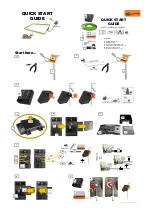
maus®2 and protects it against unintentional use e.g. by children. A value from 01 to 15 enables the ex-
perts’ programming mode and defines the time you have to push the button ‘P’ to enter the programming
tool.
C6 – the basic definition of the speed step mode
. This setup defines the default speed step mode for
any loco. The display indicates it by horizontal bars: one bar means 14 speed steps, two bars 28 and 3
bars symbolize 128 speed steps. For every individual loco you can change this setup. An example: you
have selected 28 speed steps as default for all locos then you can set individually 128 speed steps for
the locos 04, 19 and 73 and 14 steps for the address 01 because this loco only supports this mode.
C7 – the reset-function
restores the factory defaults of this individual Lokmaus®2. C7 normally is 00.
Setting it to 01 causes the reset. All menus of this Lokmaus are re-defined in the way it came from the
factory.
C8 – the number of addressed devices
defines how many devices are addressed by the master Lok-
maus®2. Only a device that is addressed can send information to the master-Lokmaus®2 in order to
control a loco or in order to operate a turnout drive. Therefore you must increment the number of addres-
sed devices if you use more than 5 devices such as Lokmaus®2 or turnout keyboards 10770. The ad-
dresses 29 and 30 that are reserved for the Translator 10759 and the Lenz interface LI100 are always
addressed and don’t have to be included in your calculation. It is not useful to raise this number higher
than the number of devices you use because it slows down the reaction of the system.
C9 – choice of the programming methods
that are executed by the Lokmaus®2. The Lokmaus®2
can program a loco by four methods (see page 25). Any programming method takes time so it is not use-
ful to execute methods that are not necessary. By this menu you can disable those methods. The follo-
wing table shows the values for C9 and the programming methods you select by this values:
C9
AO
RG
CV
PM
C9
AO
RG
CV
PM
00
—
—
—
—
08
on
—
—
—
01
—
—
—
on
09
on
—
—
on
02
—
—
on
—
10
on
—
on
—
03
—
—
on
on
11
on
—
on
on
04
—
on
—
—
12
on
on
—
—
05
—
on
—
on
13
on
on
—
on
06
—
on
on
— (default)
14
on
on
on
—
07
—
on
on
on
15
on
on
on
on
AO = address only, RG = register mode, CV = CV direkt, PM = paged mode
Default is 14 (at the Lokmaus®2 that are included in the starting sets 41203 and 41212 default is 06) that
means that the Lomaus®2 executes the three methods address only, register and CV direct one after
the other.
Only the setup of the master-Lokmaus®2 takes effect. The setup of the slave Lokmaus®2 takes no ef-
fect but is stored in this Lokmaus®2.
CA – the autoconfiguration
procedure is managed by this menu. The autoconfiguration automatically
searches the next free RocoNet address if a device is plugged the first time to a system. By default this is
set to 01 in order to unable this procedure. By 00 you disable this procedure. In this case you have to de-
fine the device address yourself. This makes only sense if there are problems with the autoconfiguration
or if autoconfiguration is not supported by the system the Lokmaus®2 is plugged to.
CB – the software-version of the Lokmaus®2
is displayed. The display tells you the software-version
of this individual Lokmaus®2. The function is read-only. You can’t change it.
CC – the software-version of the RocoNet
is displayed. The display tells you the version of the Roco-
Net. The function is read-only. You can’t change it.
Combination of digital and non-digital parts of a layout
All ROCO digital locomotives also run on conventional DC layouts (except the versions for the Märklin
Motorola digital system that run on a conventional AC layout). The loco decoder automatically detects
the system he is running in. Therefore it is easily possible to construct a layout that combines digital an
conventional sections e.g. in the phase of converting your layout from conventional to digital. In this pha-
se not digitalized locos can run on the DC-section of your layout without problems parallely to the digital
locos that can run on both sections.
29


































